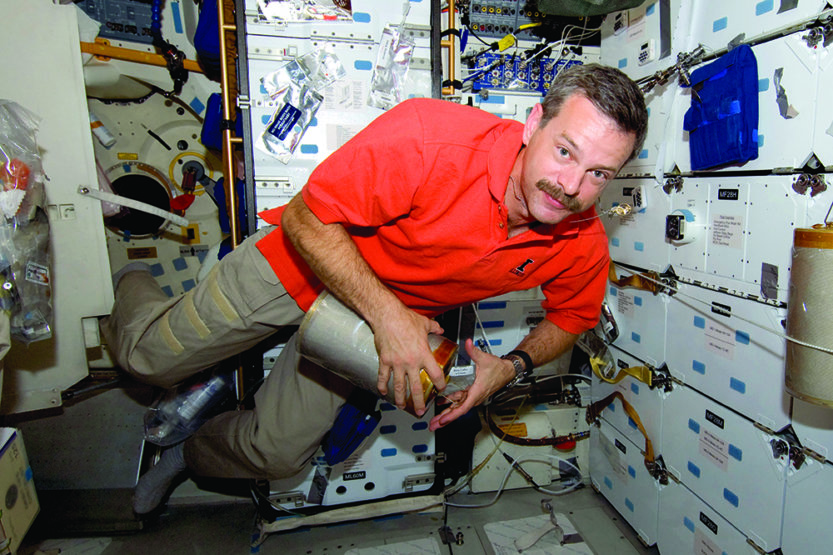Alumni Interview: Scott Altman
 “Going into space offered me a life-changing perspective,” says former NASA shuttle pilot and astronaut Scott Altman, ’81 ENG. (Image courtesy of NASA)
“Going into space offered me a life-changing perspective,” says former NASA shuttle pilot and astronaut Scott Altman, ’81 ENG. (Image courtesy of NASA) I always wanted to fly: It was my passion from the time I was 3 years old.
I got an appointment to the Air Force Academy. Unfortunately, at the pre-induction physical, they measured my sitting height—which was 39-1/2 inches—and told me I was too tall to be an Air Force fighter pilot. Instead, I decided to go into aeronautical engineering, and Illinois was the obvious choice. At UI, the Navy sent me a recruiting letter with some information. It turned out the Navy’s max-sitting height was 41 inches. So I was in!
The ultimate fighter at the time was the F-14 Tomcat. I had a blast flying them, being out at sea and doing missions over Iraq.
I suppose some of the most fun I had was flying an F-14 for the movie Top Gun. The director wanted to film at Naval Air Station Miramar. My squadron had just gotten back from a long cruise, and we were available. Normally pilots don’t get to say, “Hey, Goose, it’s time to buzz the tower.” If you do that kind of stuff in real life, they rip off your wings when you land and send you home. But I got to “buzz the tower” nine times!
Flying in outer space as a NASA shuttle astronaut is a unique experience. It’s an incredible ride to rocket into orbit after only 8-and-a-half minutes. And nothing compares with the view of Earth from space.
Returning to Earth is another interesting experience. From the moment you burn your engines 12,000 miles from touchdown, the one thing you know for sure is you’re going to hit the ground.
Returning to Earth is another interesting experience. From the moment you burn your engines 12,000 miles from touchdown, the one thing you know for sure is you’re going to hit the ground—and you have only one chance to put the wheels on the runway. Anything else is a lot less desirable.
The capstone of my career was commanding the NASA shuttle on the last service mission to the Hubble Space Telescope. Rendezvousing with the Hubble is a lot more challenging than the space station, which is a pretty stable target with big reflectors to guide you. With the Hubble, you have to hand-fly in using hand-held lasers, which are kind of like highway speed guns. Also, at the space station, if there’s a problem after inspection, you’ve got a place to hang out and wait for rescue. With the Hubble, you do your own inspection and then shelter in place if you discover a problem.
We also had to do space walks: We did five back-to-back. The head of our independent review team, Charlie Bolden (later head of NASA), told me, “There’s no way you’re going to get everything done.” But we did, and I was really proud of our team. We got the Hubble to the apex of its capability.
In 2010, NASA decided to retire the space shuttle. Because of my sitting height, I couldn’t fit into the Russian vehicle, Soyuz, so I found myself without a ride to space. I looked around at various career options on Earth and picked a company called ASRC Federal, which provides engineering services for NASA, the National Oceanic and Atmospheric Administration and the Federal Aviation Administration. I have about 250 folks who work for me in Florida, assembling the Orion spacecraft for Lockheed Martin. So I’m still playing a part in pushing the envelope and getting us back to the Moon and onto Mars.
Going into space offered me a life-changing perspective. The Hubble Telescope helped bring the universe to us. You look at just one picture of the night sky with 1,500 galaxies, each with 100 billion stars, and you realize that the universe is so vast, it’s beyond comprehension. That deepened my faith. Just as moving, though in a different way, was looking back at Earth and seeing the curvature of our planet—this really thin, bright line that goes around the horizon—and realizing that’s our atmosphere, seeing how thin it is and how fragile the Earth seems.
I’ll never forget one night when we were passing over Africa, and it was all covered with clouds. There were thunderstorms across the planet. You’d see one line of lightning go off and then another. I could feel the rhythm, the planet breathing underneath, and I thought, “What an amazing place we were born on; how fortunate we are.”

